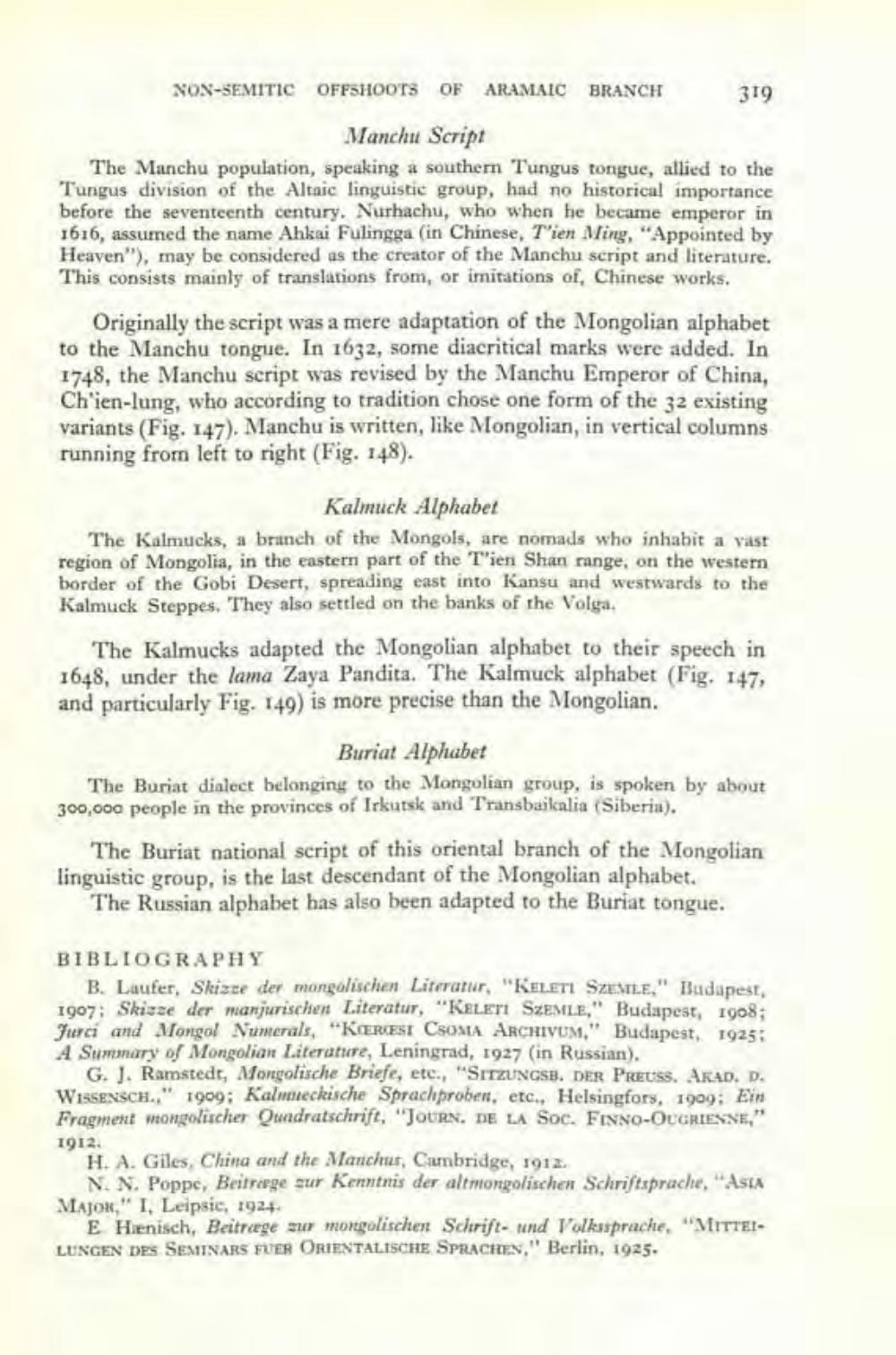________________
NON-SEMITIC OFFSHOOTS OF ARAMAIC BRANCH
Manchu Script
The Manchu population, speaking a southern Tungus tongue, allied to the Tungus division of the Altaic linguistic group, had no historical importance before the seventeenth century. Nurhachu, who when he became emperor in 1616, assumed the name Ahkai Fulingga (in Chinese, T'ien Ming, "Appointed by Heaven"), may be considered as the creator of the Manchu script and literature. This consists mainly of translations from, or imitations of Chinese works.
319
Originally the script was a mere adaptation of the Mongolian alphabet to the Manchu tongue. In 1632, some diacritical marks were added. In 1748, the Manchu script was revised by the Manchu Emperor of China, Ch'ien-lung, who according to tradition chose one form of the 32 existing variants (Fig. 147). Manchu is written, like Mongolian, in vertical columns running from left to right (Fig. 148).
Kalmuck Alphabet
The Kalmucks, a branch of the Mongols, are nomads who inhabit a vast region of Mongolia, in the eastern part of the T'ien Shan range, on the western border of the Gobi Desert, spreading east into Kansu and westwards to the Kalmuck Steppes. They also settled on the banks of the Volga.
The Kalmucks adapted the Mongolian alphabet to their speech in 1648, under the lama Zaya Pandita. The Kalmuck alphabet (Fig. 147, and particularly Fig. 149) is more precise than the Mongolian.
Buriat Alphabet
The Buriat dialect belonging to the Mongolian group, is spoken by about 300,000 people in the provinces of Irkutsk and Transbaikalia (Siberia).
The Buriat national script of this oriental branch of the Mongolian linguistic group, is the last descendant of the Mongolian alphabet.
The Russian alphabet has also been adapted to the Buriat tongue.
BIBLIOGRAPHY
B. Laufer, Skizze der mongolischen Literatur, "KELETI SZEMLE," Budapest, 1907: Skizze der manjurischen Literatur, "KELETI SZEMLE," Budapest, 1908; Jurci and Mongol Numerals, "KCEREST CSOMA ARCHIVUM," Budapest, 1925; A Summary of Mongolian Literature, Leningrad, 1927 (in Russian).
G. J. Ramstedt, Mongolische Briefe, etc., "SITZUNGSB. DER PREUSS. AKAD. D. WISSENSCH., 1909; Kalmeckische Sprachproben, etc., Helsingfors, 1909; Ein Fragment mongolischer Quadratschrift, "JOURN. DE LA Soc. FINNO-OUGRIENNE,"
1912.
H. A. Giles, China and the Manchus, Cambridge, 1912.
N. N. Poppe, Beitrage zur Kenntnis der altmongolischen Schriftsprache, "Asia MAJOR," I, Leipsic, 1924.
E Hanisch, Beitrage zur mongolischen Schrift- und Volkssprache, "MITTEI LUNGEN DES SEMINARS FUER ORIENTALISCHE SPRACHEN," Berlin, 1925.




